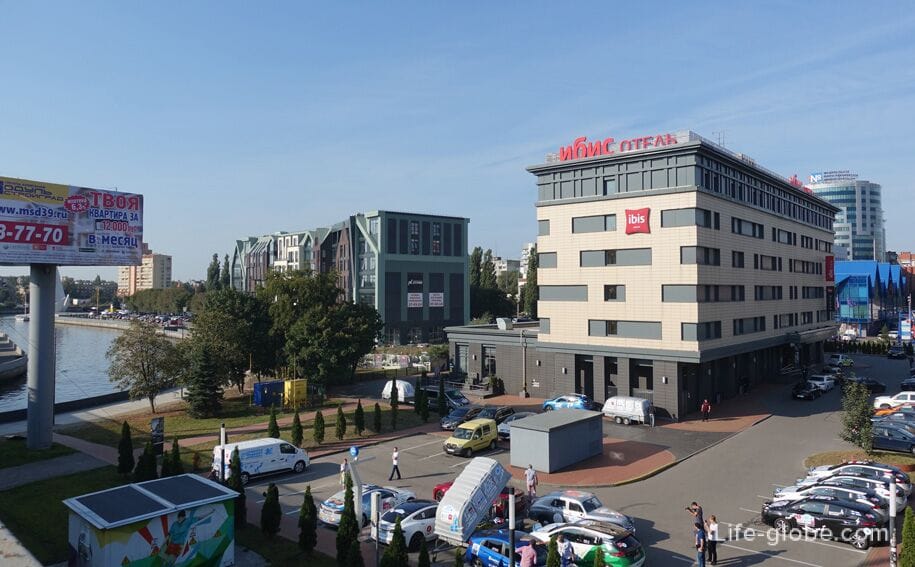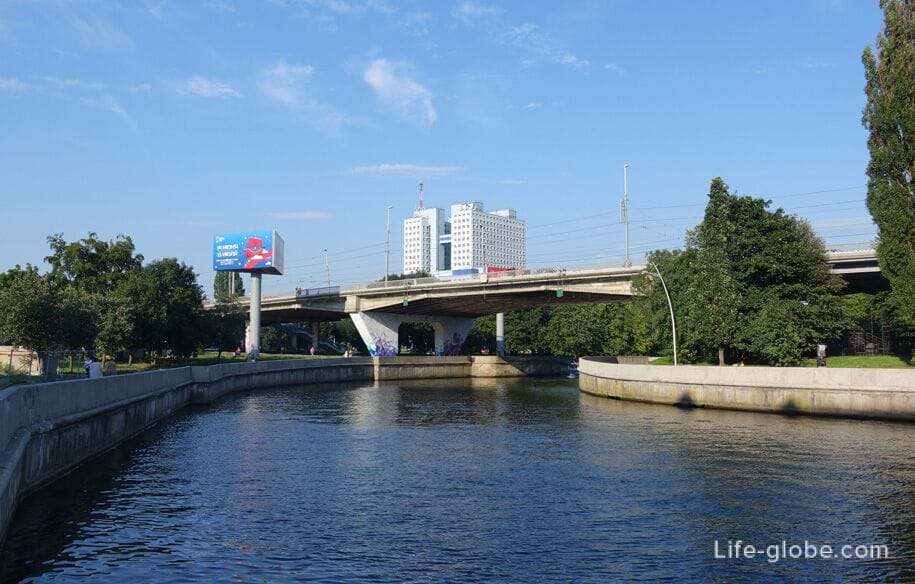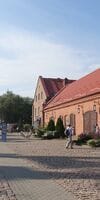Peter the Great Embankment in Kaliningrad, along with the embankment The fishing village is a landmark of the city and one of the favorite places for walking and recreation among locals and visitors of the city.
Peter the Great Embankment is located in the center of Kaliningrad, on the north side of the Pregolya River, near Kant Island and The cathedral.
The most popular and interesting part of the Peter the Great embankment is the embankment of the Historical Fleet, at the berth of which the museumified vessels included in the complex of objects of the Museum of the World Ocean are moored.
Embankment of the Historical Fleet (Old Port)
Entrance to the objects of the Museum of the World Ocean is paid, and the territory of the embankment of the Historical Fleet is free (free).
Festivals and celebrations, including annual ones, are held on the territory of the Historical Fleet embankment: Herring Day and A long sausage.
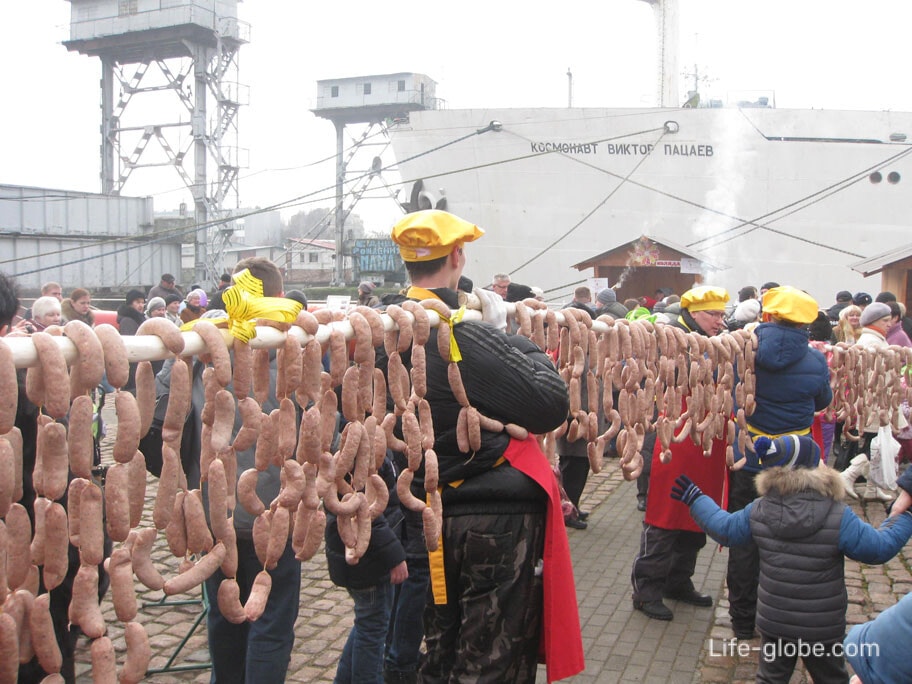

The floating lighthouse "Irbensky" is one of the means of navigation - a ship of special construction on which a lighthouse is installed, equipped with a powerful light source, used away from the coastline and at the entrances to the port as a pilot station.
Currently, an exposition from the history of navigation and lighthouse business is presented on board the Irbensky floating lighthouse. More about the floating lighthouse "Irbensky"...
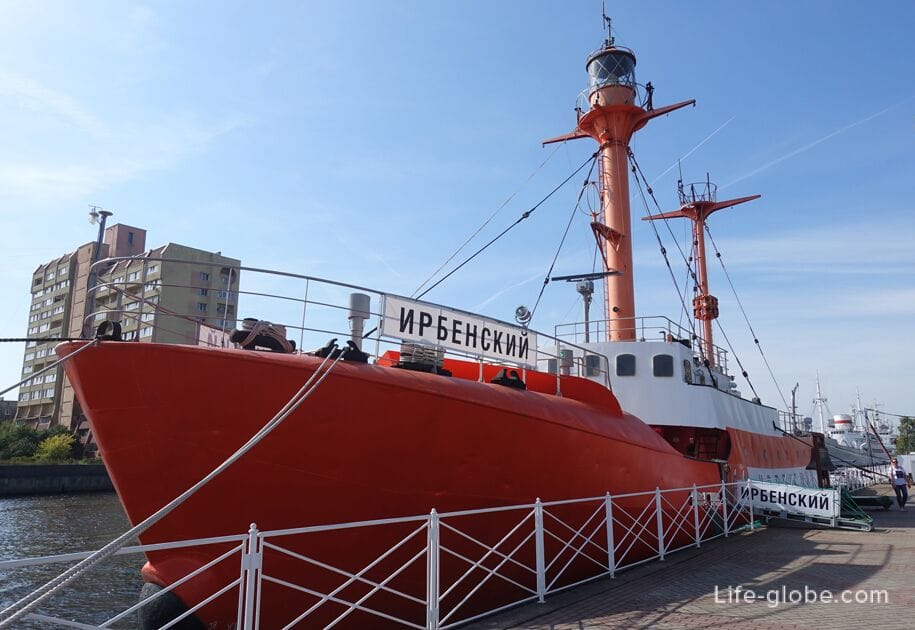
Fishing vessel "SRT-129" (medium fishing trawler) is one of the domestic fishing vessels of the post-war period and the only one preserved in the north-western region of Russia - the city of Kaliningrad.
An exposition "Pioneers of Ocean Fishing" has been created on board the museum ship, dedicated to the history of the fishing fleet of the Kaliningrad region and Russia as a whole, including telling about the work of medium-sized fishing trawlers in the ocean, the life and work of fishermen. More about the fishing vessel "SRT-129"...
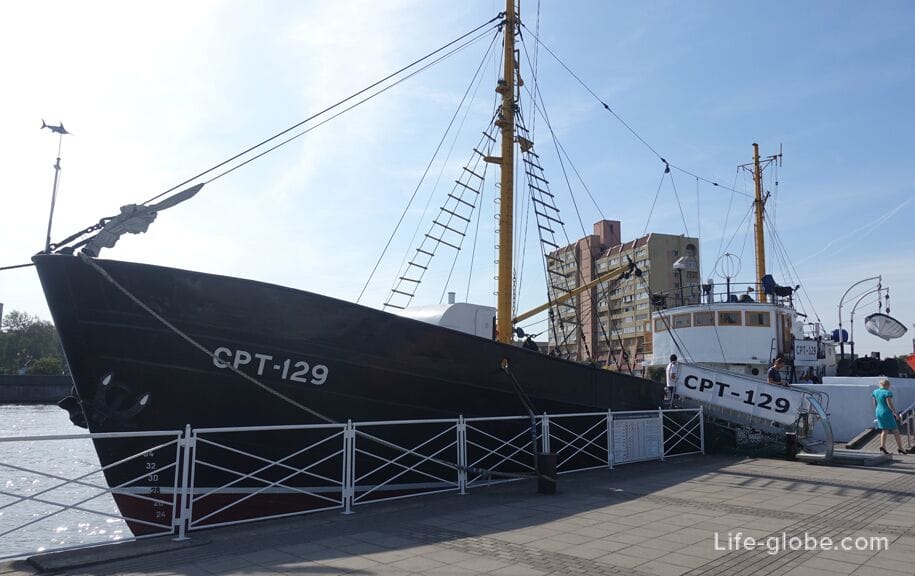
The main building of the Museum of the World Ocean (the building of the storage facility), which houses a cafe and presents the exhibition "Depth", introducing visitors to collections of barometers, current meters, hydrophysical probes, instruments and equipment for underwater surveys, studying depths and optical properties, deep-sea technology and many others. Learn more about the exhibition "Depth"...
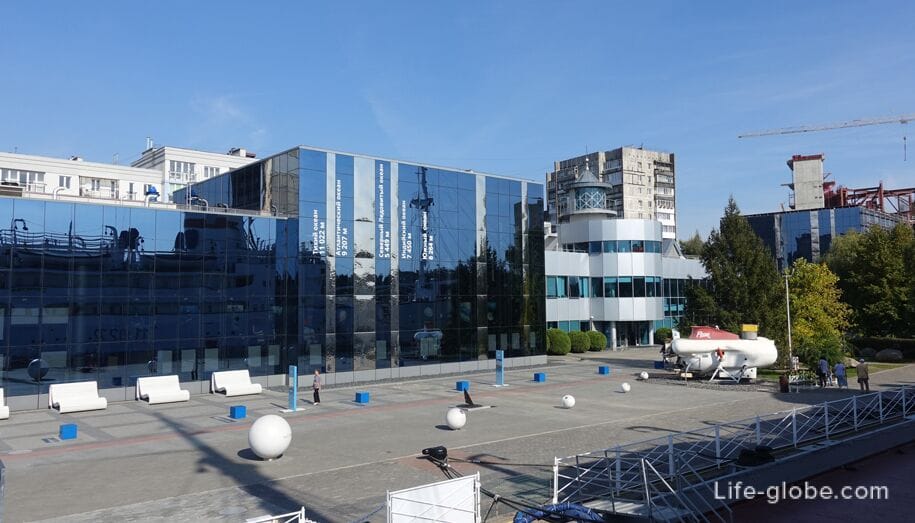


There was a port on the embankment of the Historical Fleet. The port facilities in Konigsberg were built from the XVII century. They often burned, then rebuilt, changed.
Today there are gazebos, places for walking and recreation, as well as historical and educational exhibits.
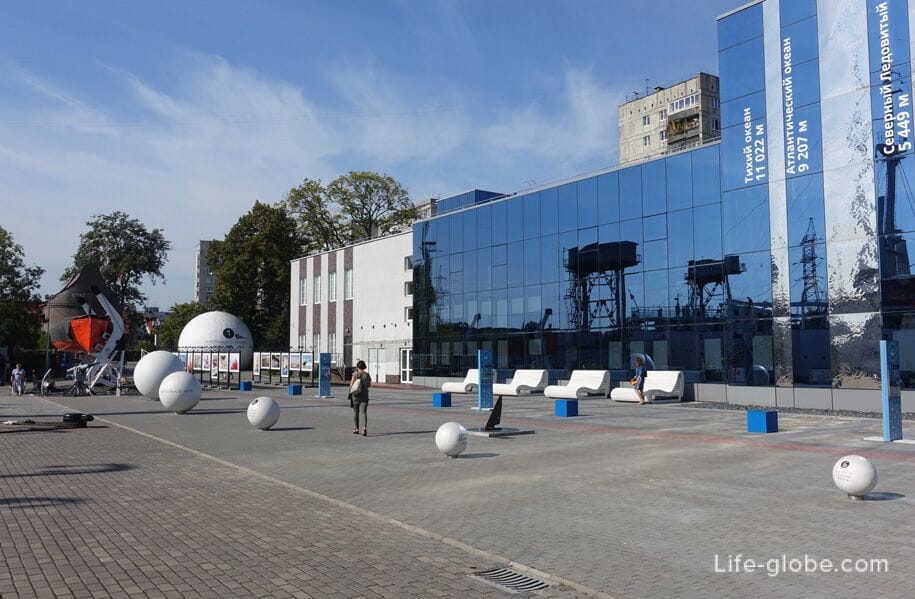
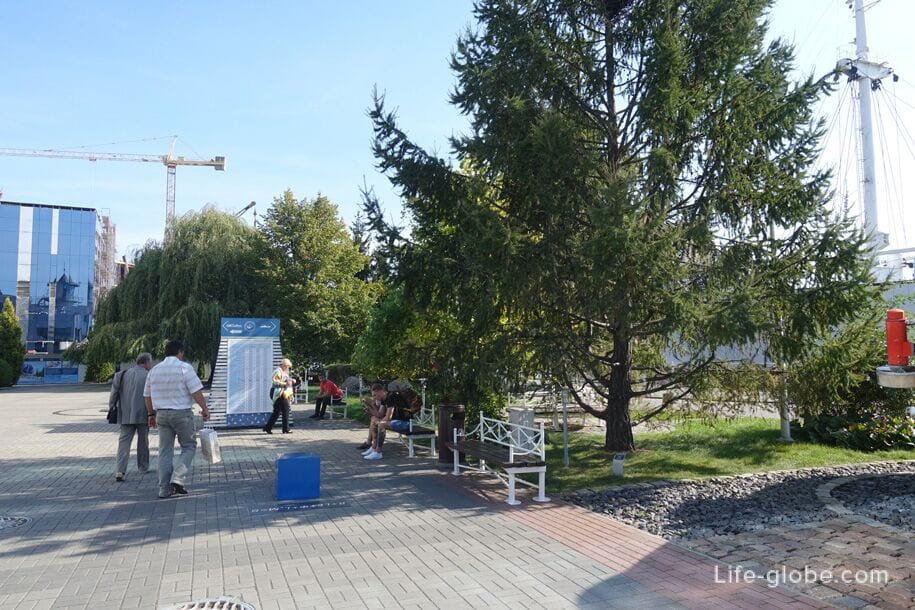
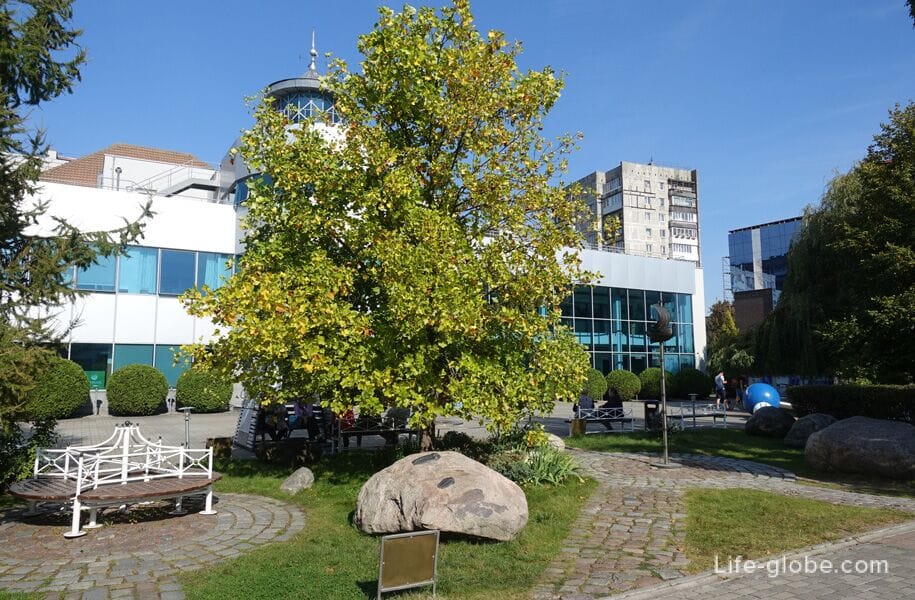
The reconciliation tree. In the year of the 50th anniversary of the end of the Second World War, the action "Hope and Reconciliation" took place. On this day, Klaus David, a member of the city council of Duisburg (Germany), planted a linden tree grown on Unter der Liden - the famous linden alley of Berlin.
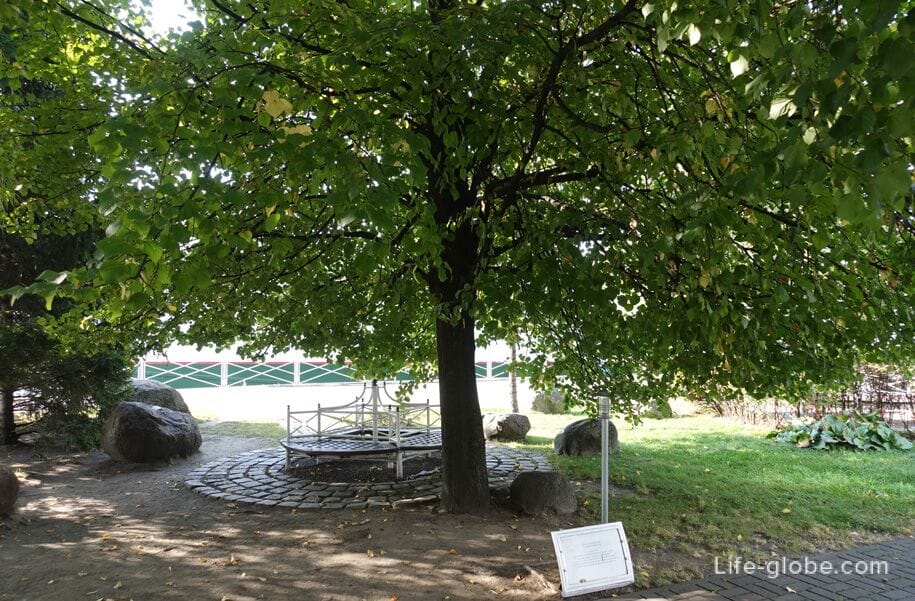
Seven feet under the keel. This expression means wishing a successful voyage. To prevent the ship from running aground, the depth under the keel must be at least two meters, or seven feet (1 foot = 0.3048 meters). Happy sailing, or seven feet under the keel!
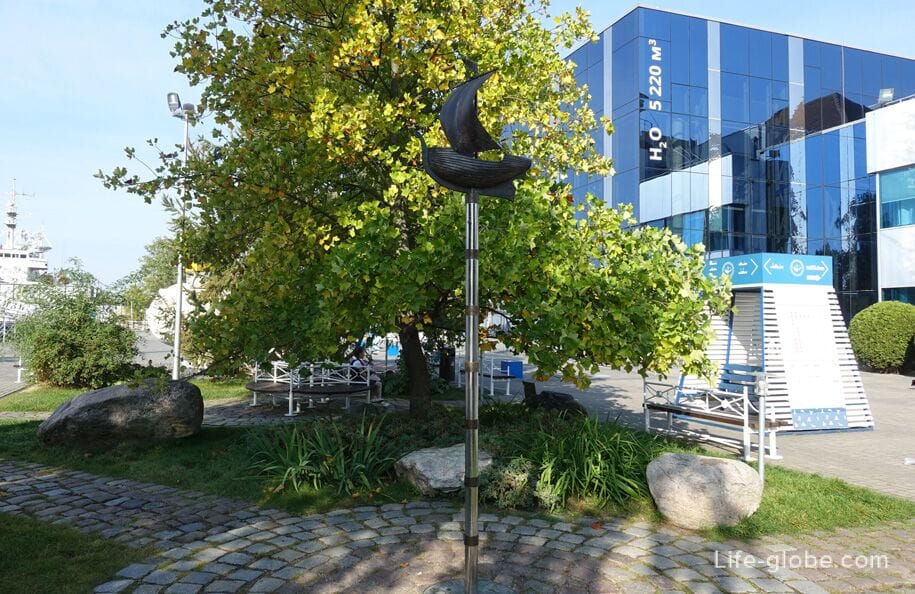
An installation of a water molecule demonstrating how two hydrogen atoms join one oxygen atom to form water molecules - H2O. The angle between the atoms is 104.45°.
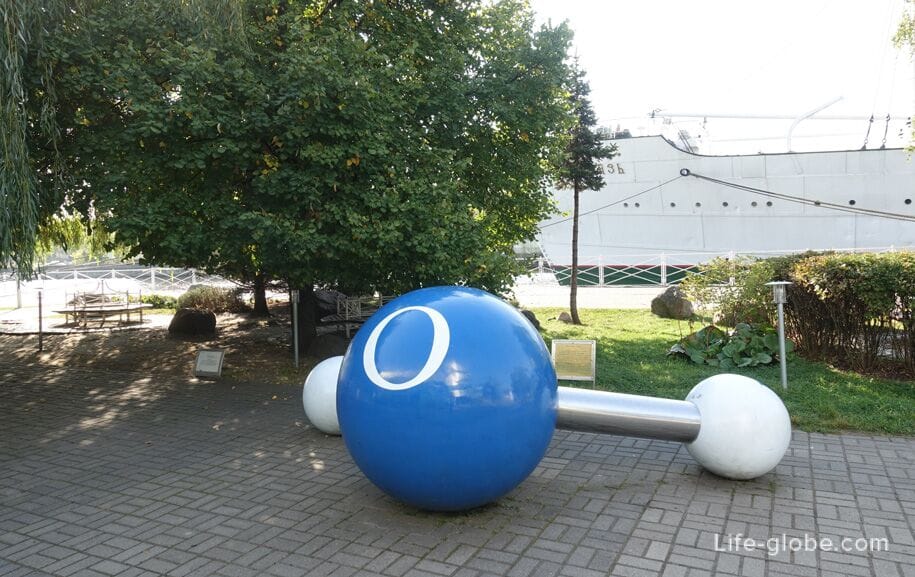
Ammonite (ammonites / ammonita) - extinct cephalopods with an outer shell. They lived in ancient seas from the Devonian to the Cretaceous period (from 395 to 65 million years ago). In most mollusks, the diameter of the shell reached 5-10 centimeters. The size of the largest ammonite found in Bavaria is about 2.5 meters.
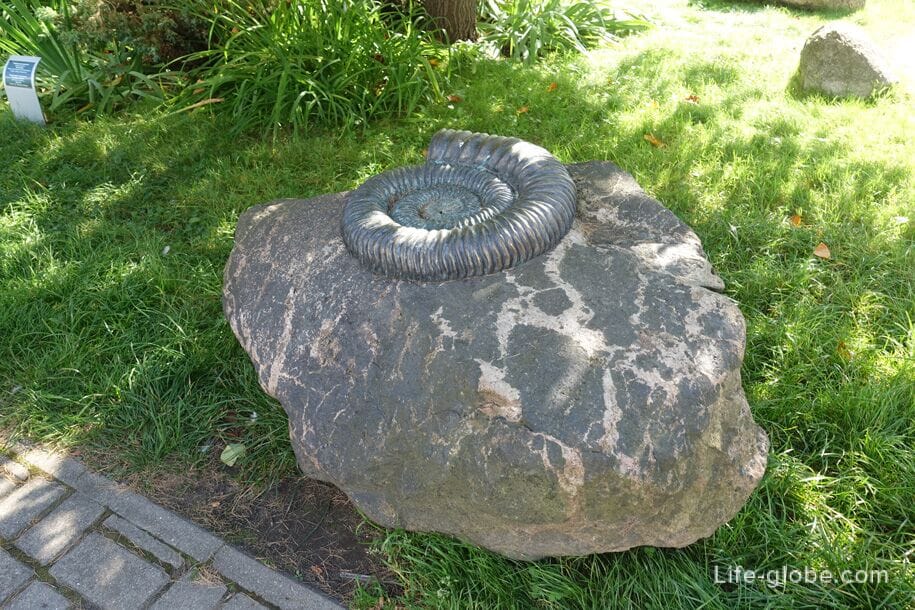
Granite
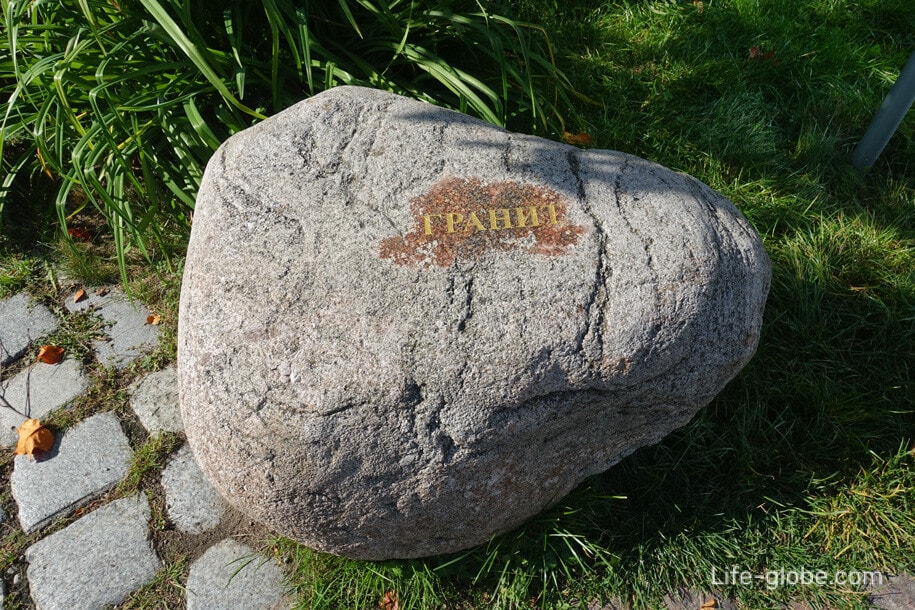
Milk quartz
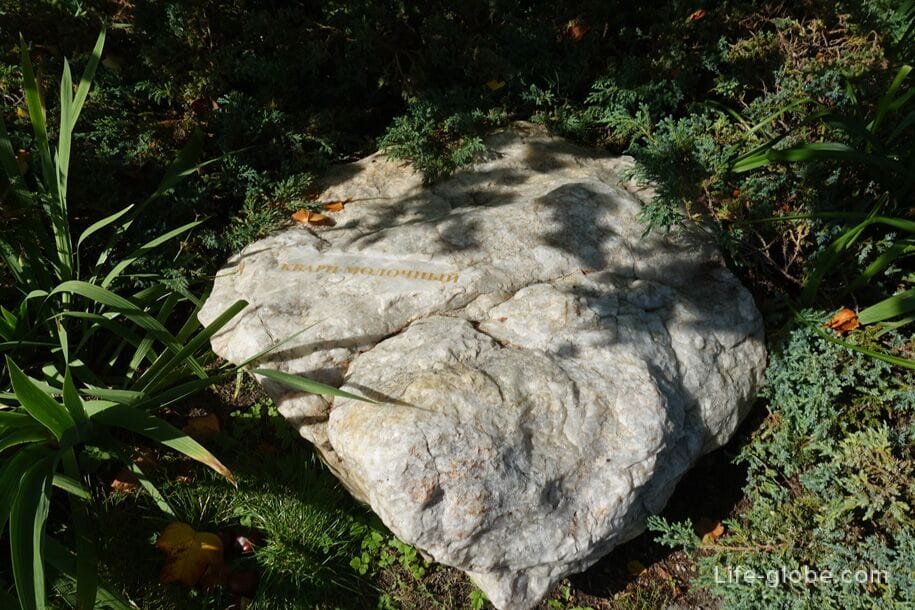
The wind rose is the designation of the main azimuths of the sides of the horizon, made in the shape of a star. Initially, the wind rose was a symbol of the navigational star for sailors. Now it symbolizes the cardinal directions and shows the repeatability of winds of a certain direction. The long ends of the star point north (N - North), south (S - South), east (E - East) and west (W - West), while the short ends mark the median directions.
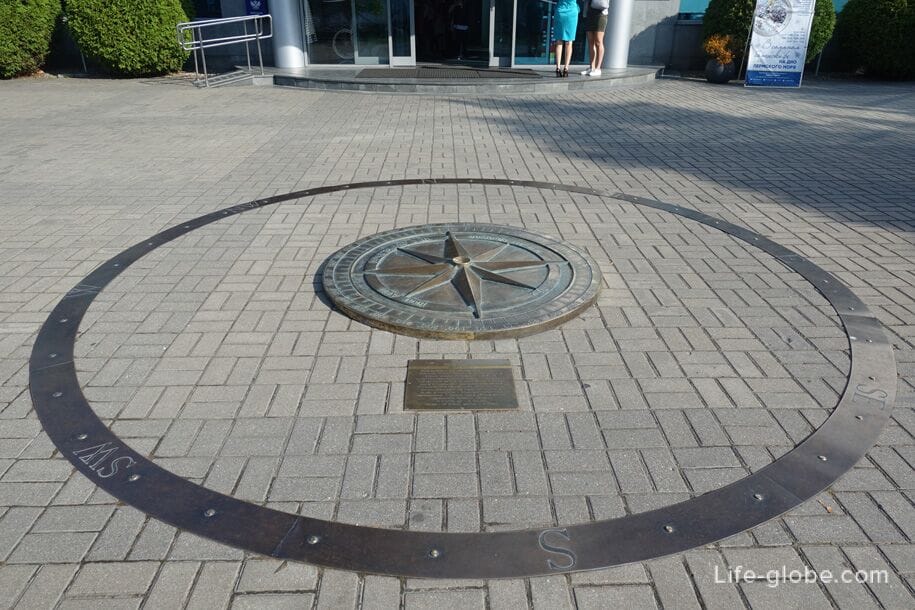
Who can keep the balance?!
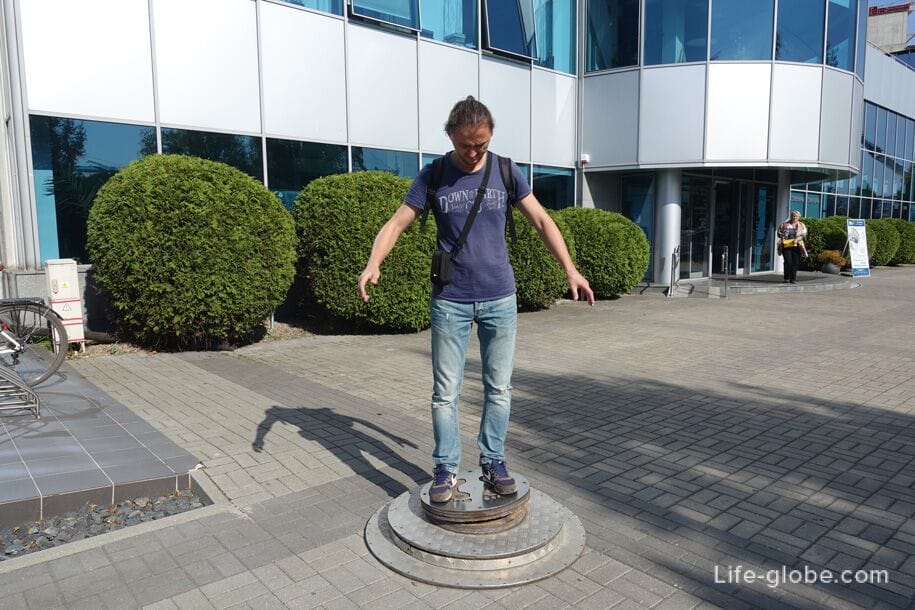
Self-propelled underwater inhabited vehicle "PAISIS-VII", designed to collect scientific data and perform applied work in and above the ocean.
The presented device was built in 1975. He worked in the Pacific, Indian and Atlantic Oceans, as well as on Lake Baikal. With its application, about 30 scientific studies were conducted, in which unique data were obtained in the field of geology, biology, hydrophysics, hydrochemistry and hydroacoustics. The device has performed more than 300 dives to a depth of 2140 meters. It has not been operated since 1998.
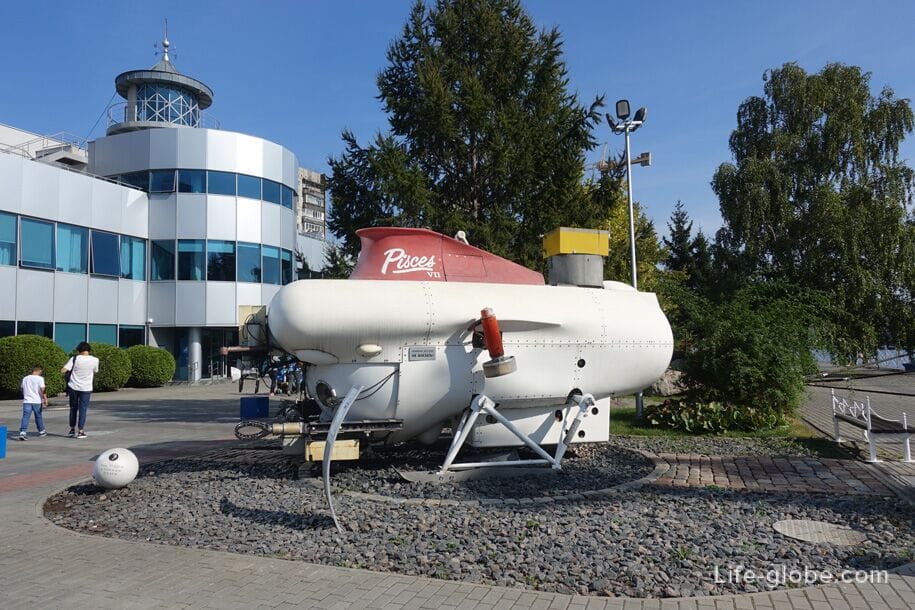
Exhibits:
- open lifeboat of the barque "Kruzenshtern", with a capacity of 51 people and a seaworthiness of 7 points;
- a gravity double-hinged davit is a device for launching a boat from the side of a vessel into the water and lifting it on board with the help of winches. Each boat is serviced by two davits;
- acoustic profiler designed to search for various objects on the ocean floor and in the ground, as well as to study the vertical structure of the bottom soil;
- harpoon gun (USSR, 60s of the 20th century) - a whaling gun installed on the deck of a whaling vessel;
- the gaff of the barque "Kruzenshtern" is part of the mizzen mast.

The "Voice of the Ocean" object, by entering which, you can "find out" how the World Ocean sounds. An interactive hydrophone exhibit is placed inside the spherical shell, clicking on one of the buttons of which, you can hear the voices of the inhabitants of the World Ocean, sounds of a natural and man-made nature.
In addition, in the "Voice of the Ocean" you can hear how your own voice sounds from the outside and observe the phenomena of echo and reverberation - multiple reflections of sound in a confined space.
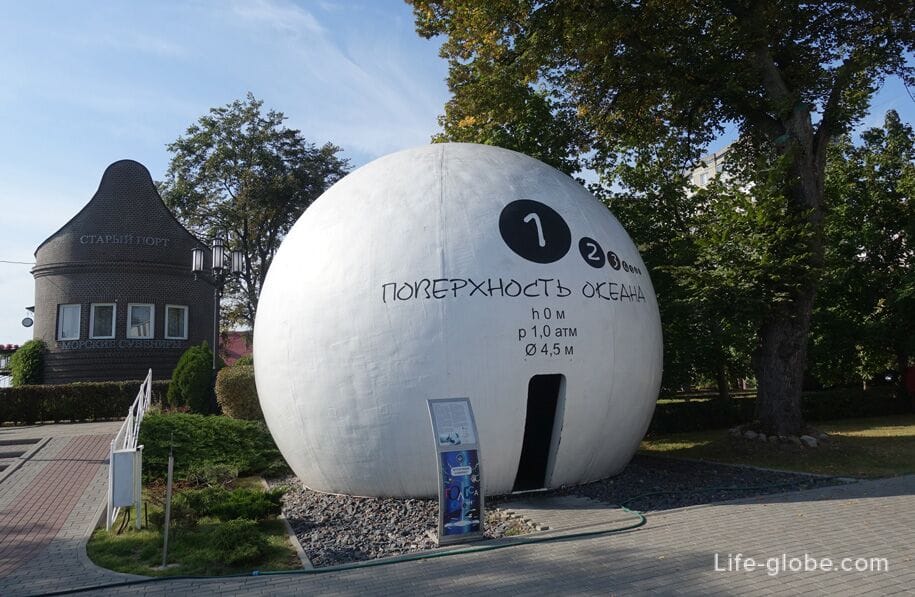
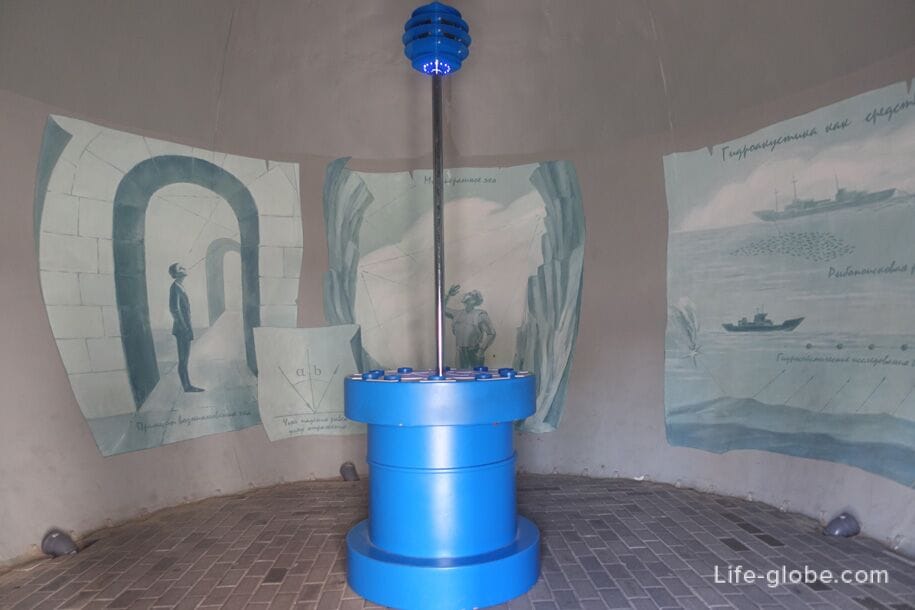
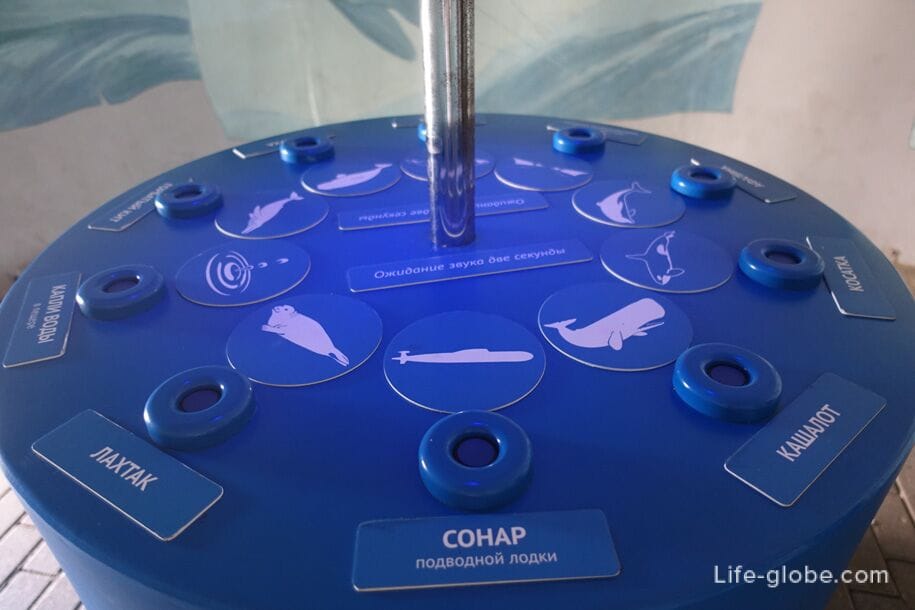
The research vessel "Vityaz" (NIS "Vityaz") is a legendary vessel in the history of oceanology, which has made an outstanding contribution to the study of the World Ocean.
Currently, on board the ship, you can walk along the decks, see the expositions presented in the halls of the ship, look into the cabins and feel the life of people on sea expeditions, and if you want, even live in the "walls of the Vityaz" - the guest cabins of the Vityaz function on the ship. More about the vessel "Vityaz"...
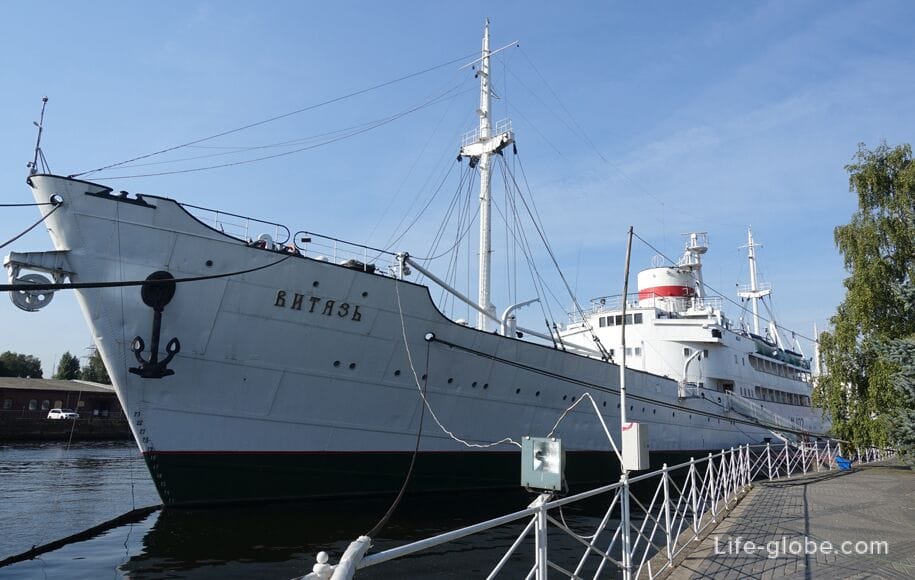
A rocking machine is a part of the ground equipment of a rod deep-pumping unit used for mechanized extraction of liquid through wells using a rod pump driven by a rocking machine.
Old sliding railway bridge (now defunct) - the first railway bridge over the Pregel River (now Pregolya) in Konigsberg (now Kaliningrad), which connected the districts of Forstadt and Laak, built in 1862-1865. There were pedestrian paths on both sides of the bridge.
In 1929, the bridge was decommissioned, but measures were taken to prevent its destruction. The lifting tracks to the bridge have been preserved. The bridge is owned by the Kaliningrad Railway and crosses the territory of the embankment of the Historical Fleet of the Museum of the World Ocean.

The old part of the port - landscape park "Old Port"
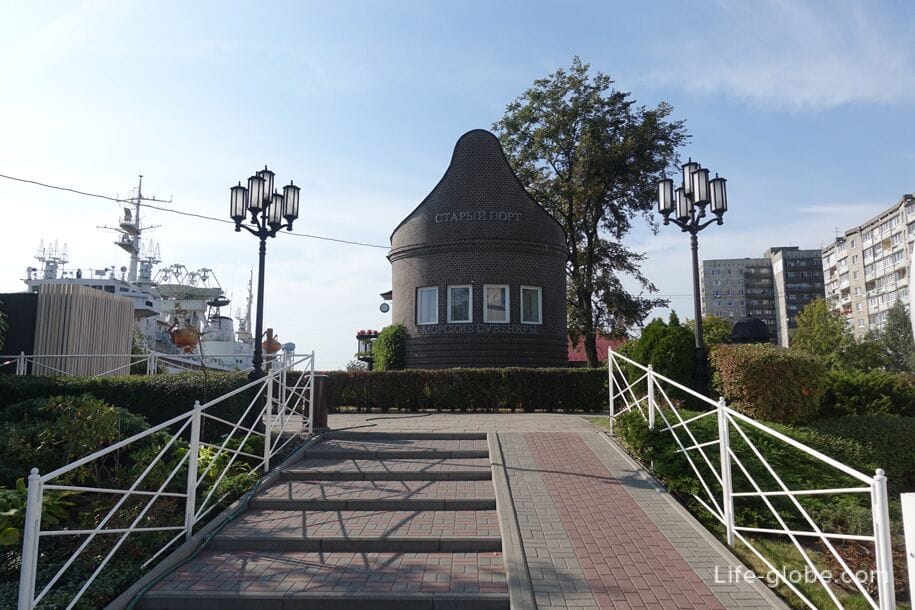
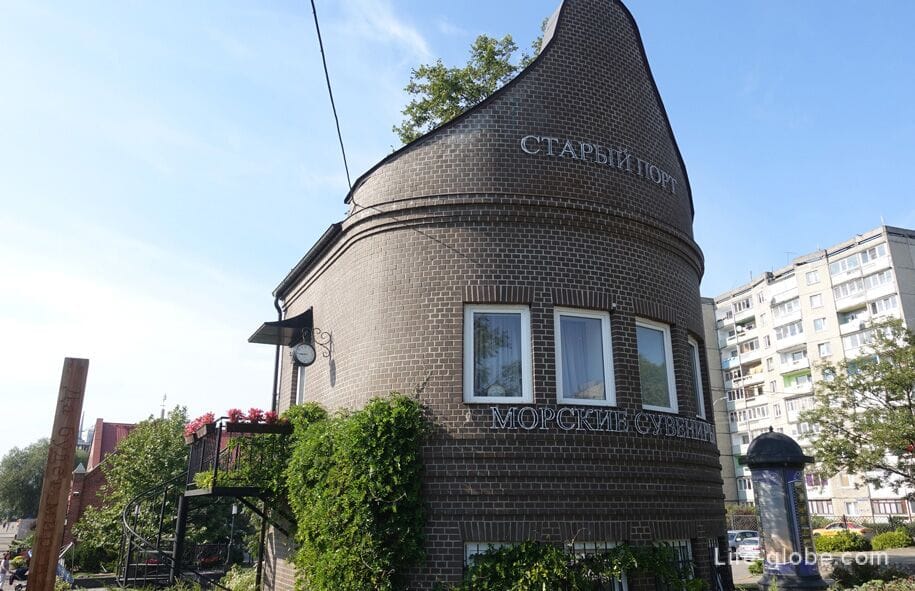
On the opposite, plastered end of the building, there is a map of the "Seven Bridges of Konigsberg", which carries a riddle.
The riddle of the seven bridges was common among the residents of Konigsberg: "How to cross all the bridges without crossing any of them twice?".
Even the outstanding mathematician of the 18th century, Leonard Euler, could not solve this problem, but it prompted him to a number of important discoveries. Maybe you can solve it?

Decorative stream with fountains and a bridge
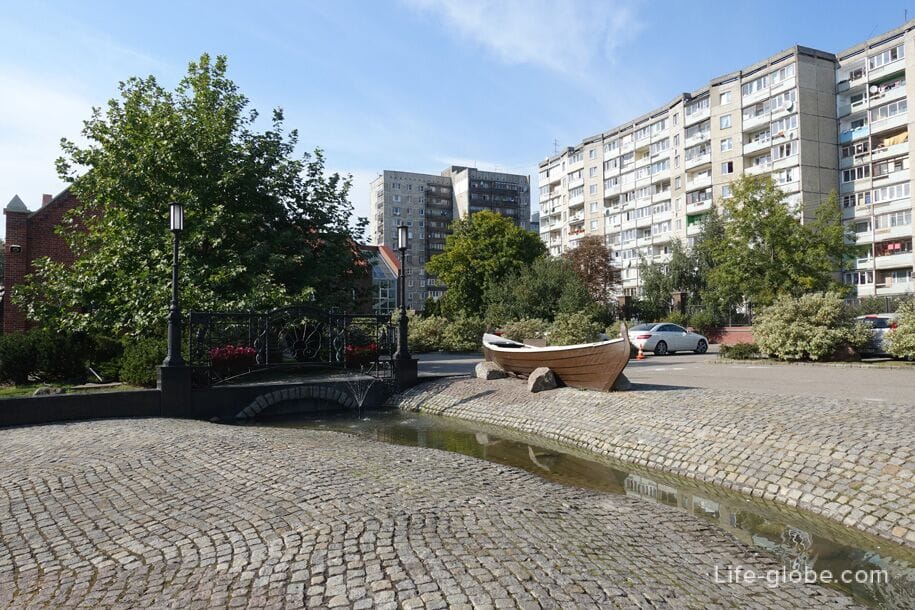
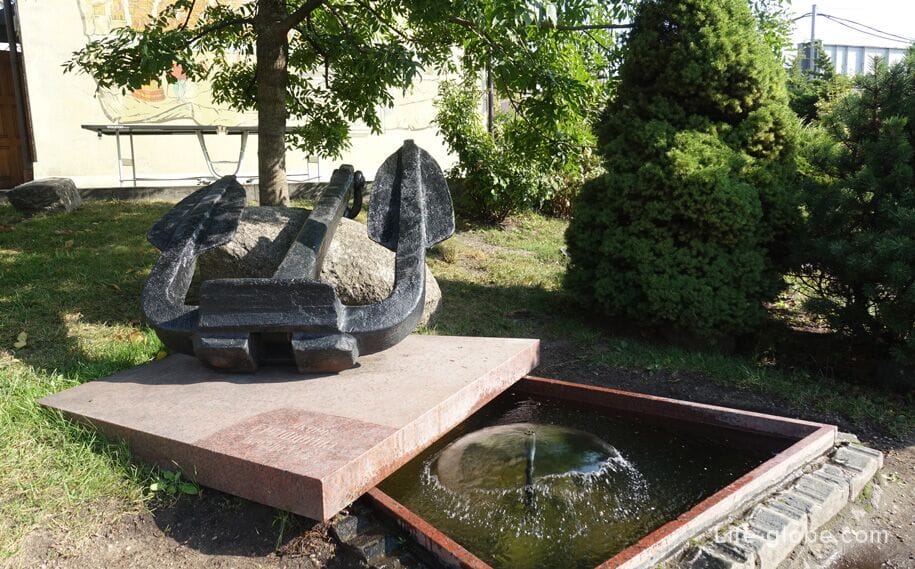
A star umbrella, the dome of which is decorated with the brightest stars of the northern hemisphere of the Earth. The lines connecting them form the characteristic contours of the constellations. The direction of the "handle" coincides with the direction of the earth's axis and corresponds to the geographical latitude of Kaliningrad. The axis points to the North Pole of the world, coinciding with the Polar Star from the constellation Ursa Minor. The rotation of the umbrella from east to west corresponds to the real rotation of the celestial sphere.
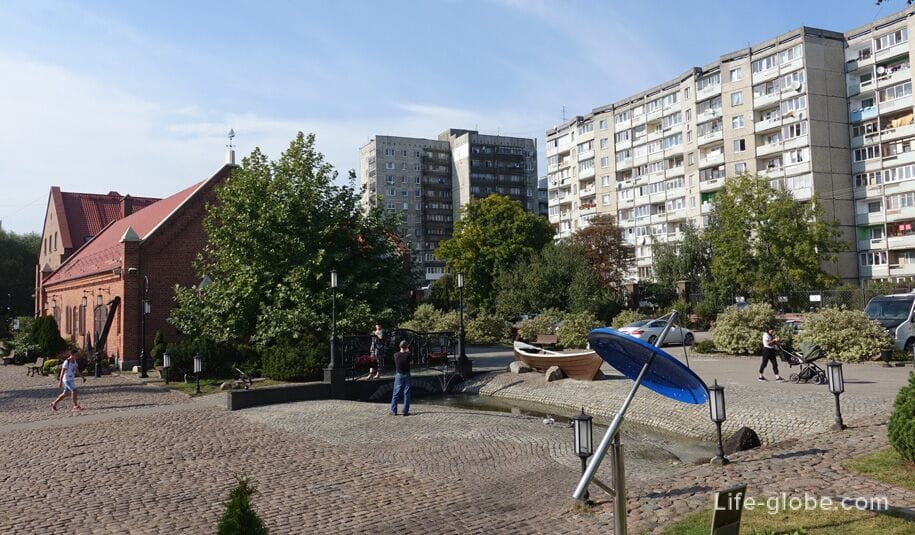
The Cosmonaut Viktor Patsaev research vessel is the only space communication vessel in the world that has a museum exposition on board. The ship was moored at the embankment of the Historical Fleet in 2001.
The ship is named after cosmonaut Viktor Ivanovich Patsaev, Hero of the Soviet Union, a Kaliningrad citizen. On November 24, 1978, the pennant of the USSR Academy of Sciences was raised on the ship. Until 1994, it was part of a command and measurement complex designed to monitor and control the flights of satellites and interplanetary stations, to receive and process information, as well as establish communication with astronauts. It was a floating measuring point in the waters of the World Ocean. To carry out this work, the ship was equipped with a universal telemetry system and special equipment.
The ship is now not fulfilling its former tasks.
Visiting the ship is only possible as part of an excursion.

Gallery of anchors. Anchors are mainly classified by the number of horns and paws. Two-horned anchors are usually used as anchors. Today, there are about 5,000 types of anchors known in the world. The museum collection includes more than 70 anchors of various types, differing in time and place of manufacture.
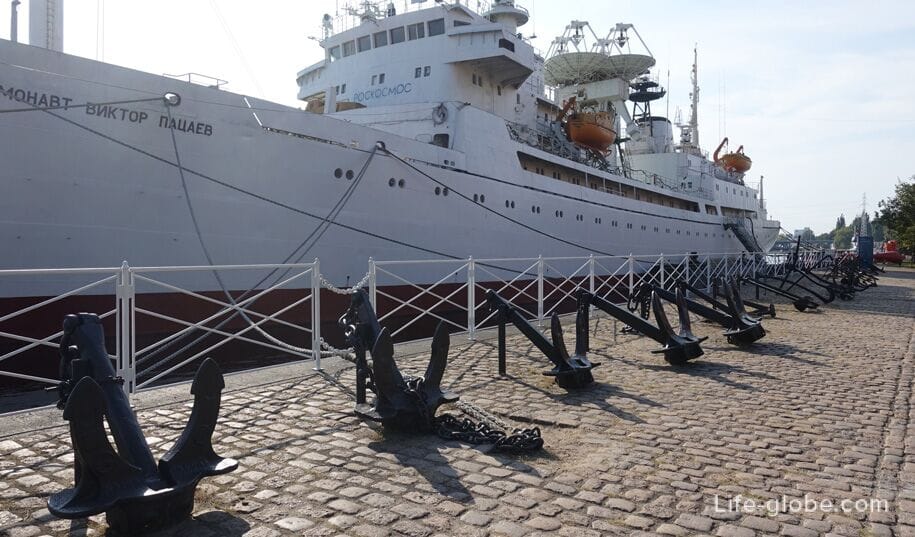
A model of the solar system showing the 9 largest bodies of the Solar System: in the center is the Sun - the closest star to us, around which 8 planets revolve: Mercury, Venus, Earth, Mars, Jupiter, Saturn, Uranus and Neptune.
All the planets move counterclockwise, almost in the same plane, but each in its own orbit. For this reason, their location in outer space is constantly changing, as is the view of the starry sky from Earth.

Tellurium (from the Latin "tellus" - earth) is a device that demonstrates the movement and location of the Sun, Earth and Moon in relation to each other.
The Earth's axis passes through the center of the planet and keeps the direction unchanged. The Moon, the satellite of our planet, orbits the Earth. The change of day and night occurs as a result of the rotation of the Earth and the Moon around its axis under the rays of the Sun. The movement of the Earth around the Sun leads to a change of seasons. If the Moon, Sun and Earth line up in one line, then an eclipse occurs.
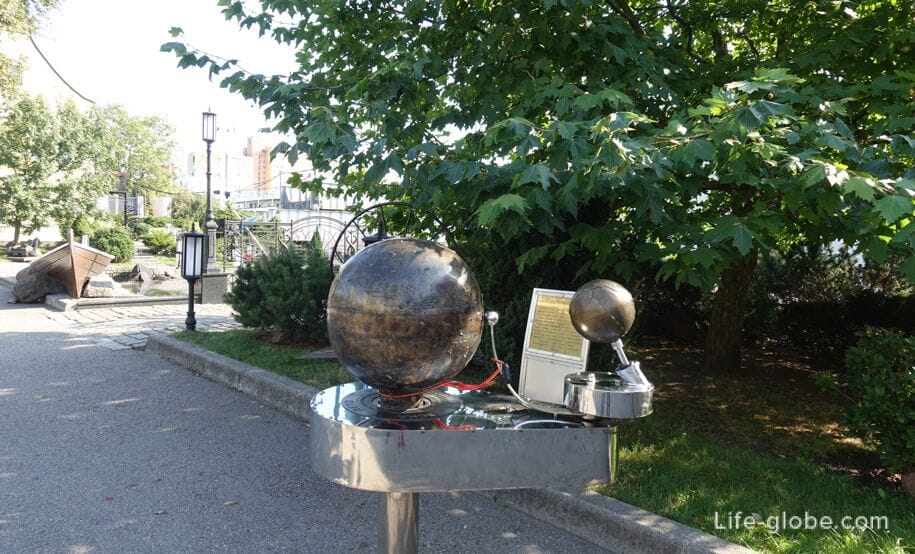
Fountain "Putti" or fountain of angels (an object of cultural significance of regional significance), created by Stanislav Kauer in 1908. At the international fountain exhibition held in Posen (now the city of Poznan, Poland) in 1912, "Putti" took first place.
For many years, the fountain was not used and was destroyed. In 2011, at the initiative of the Museum of the World Ocean, the fountain was restored and placed on the territory of the "Old Port".
On the wall of the previously restored warehouse warehouse there is a relief "Genius" or "Squatting girl" (possibly a work of 1912). The author's repetition, an artificial stone, a gift from the Usachev family living in Kaliningrad.
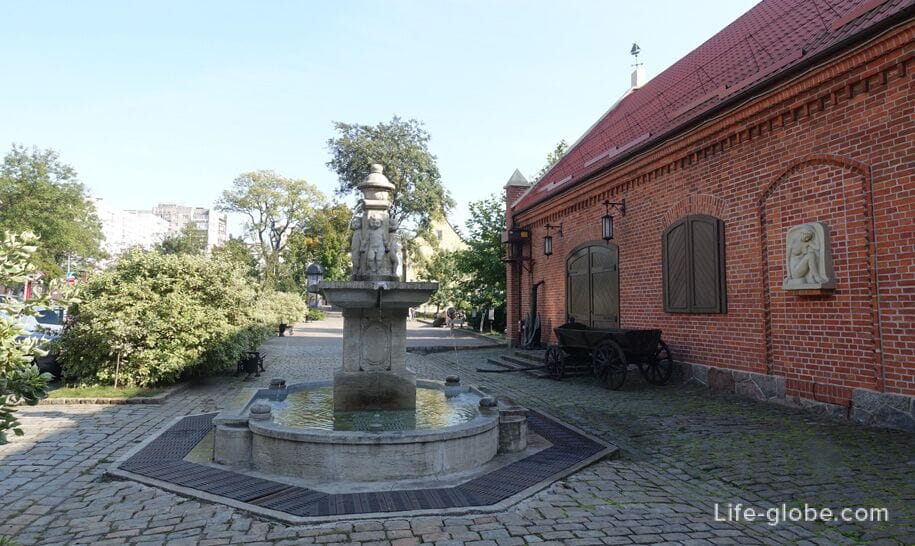
Fountain on the old embankment

The port warehouses that can be seen on the embankment along the Pregolya River, where the museum's exhibition buildings are located today: "Marine Konigsberg-Kaliningrad" and "Warehouse" were built in the middle of the 19th century. In the same period, probably, there was a mooring wall and a cobblestone pavement.
The territory located along the Pregel River was destroyed during the Second World War. The mooring wall and pavement were restored by the Museum of the World Ocean in 2000-2003, the buildings - in 2006-2007.
The Warehouse exhibits major Russian and foreign exhibitions. The Marine Koenigsberg-Kaliningrad building houses an exhibition of the same name and a restored 19th-century ship found in the quarry of the Amber Combine.
The Warehouse exhibits major Russian and foreign exhibitions. The Marine Koenigsberg-Kaliningrad building houses an exhibition of the same name and a restored 19th-century ship found in the quarry of the Amber Combine.
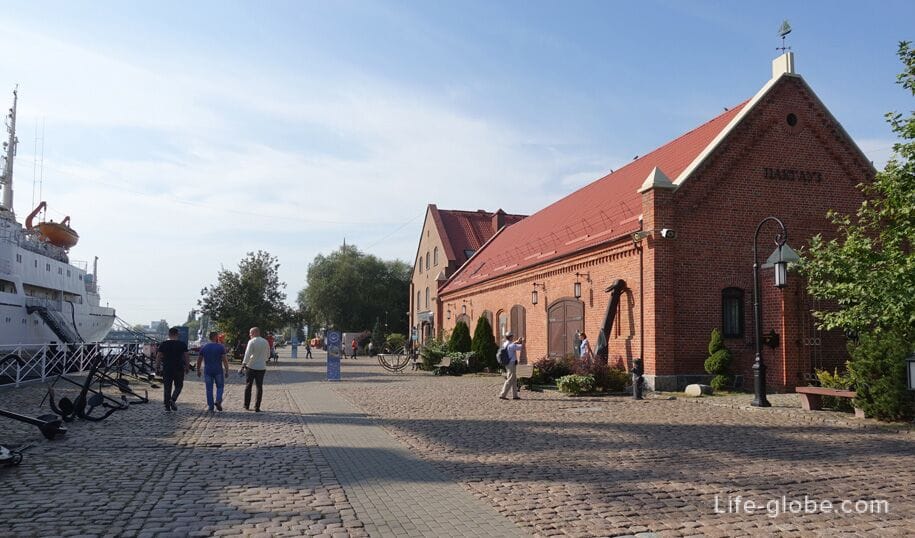


Near the warehouse building, you can see a large anchor, a stylized column and an old mailbox attached to the warehouse wall.
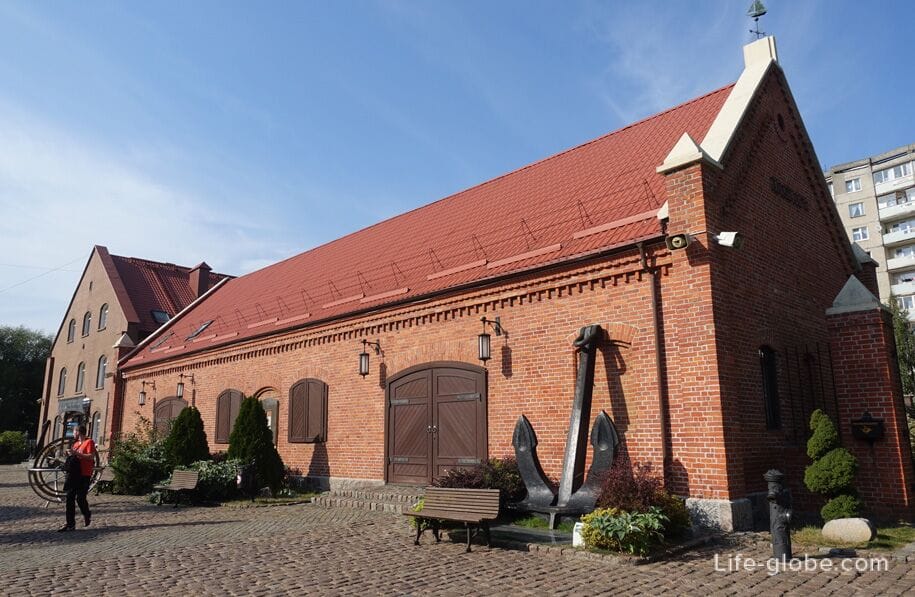
On the wall of the old former port warehouse there is a Speicher sign "Noah's Ark". The first lasadias (port warehouses) were built in Konigsberg in 1327. The owner of each warehouse had his own speicher sign, which depicted a unique drawing.
Currently, the Speicher sign "Noah's Ark" symbolizes the continuity of the maritime history of Konigsberg-Kaliningrad.
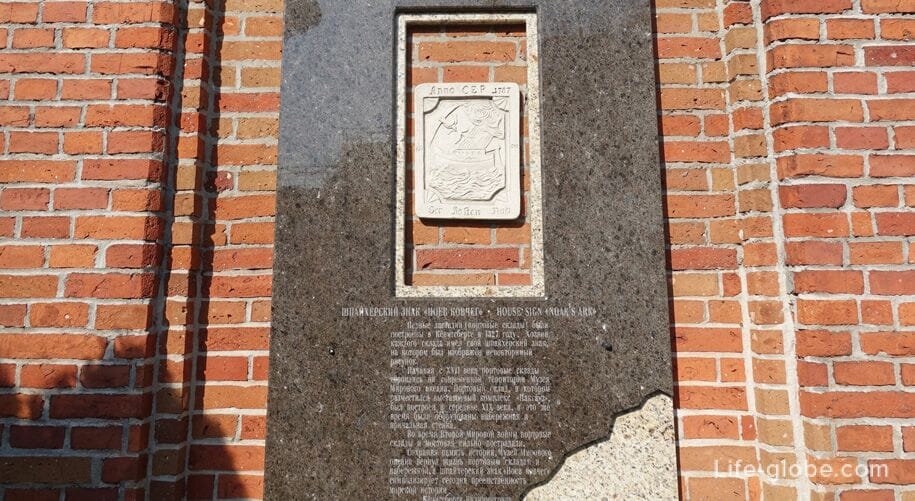
Next to the warehouse there is a stylized "Kant's bench", which is one of the semantic dominants of the museum territory.
Presumably, at the turn of the 18th and 19th centuries, there was a route in this place, along which the great philosopher and professor of Albertina Immanuel Kant often walked. This route has received the name "Kant's trails" in history. In his declining years, the scientist liked to come to this port area, sit on a bench and watch the busy life of the old Konigsberg port. As Immanuel Kant said: "To see the whole world, you don't have to leave Konigsberg - it's enough to come to the port and see it."
On Kant's bench are the "cocked hat and walking sticks of the philosopher" (not real, of course).
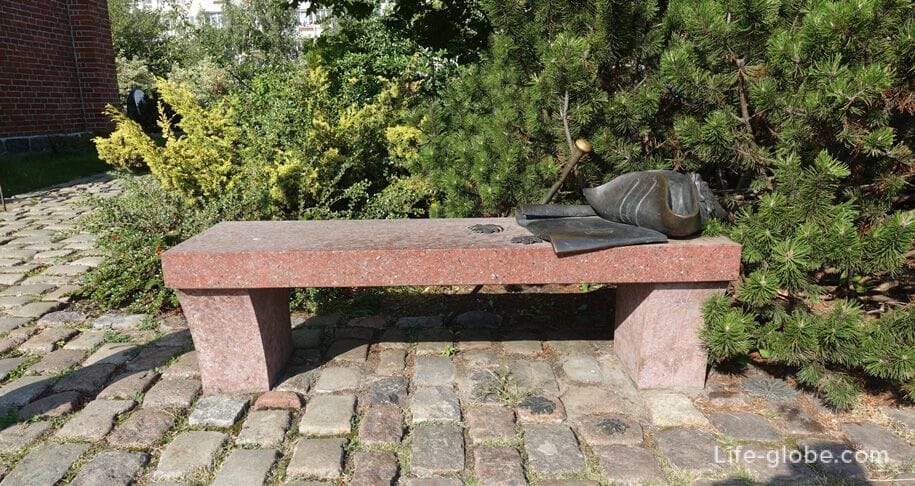
Armillary sphere (from Latin "armilla" - bracelet, ring) is an astronomical instrument for determining the coordinates of celestial bodies. Its invention is attributed to the ancient Greek geometer Eratosthenes (III century BC).
The armillary sphere consists of a movable part depicting the celestial sphere with poles and tropics. Armilla rings represent the most important lines of the celestial sphere: horizon, meridian, equator, ecliptic.
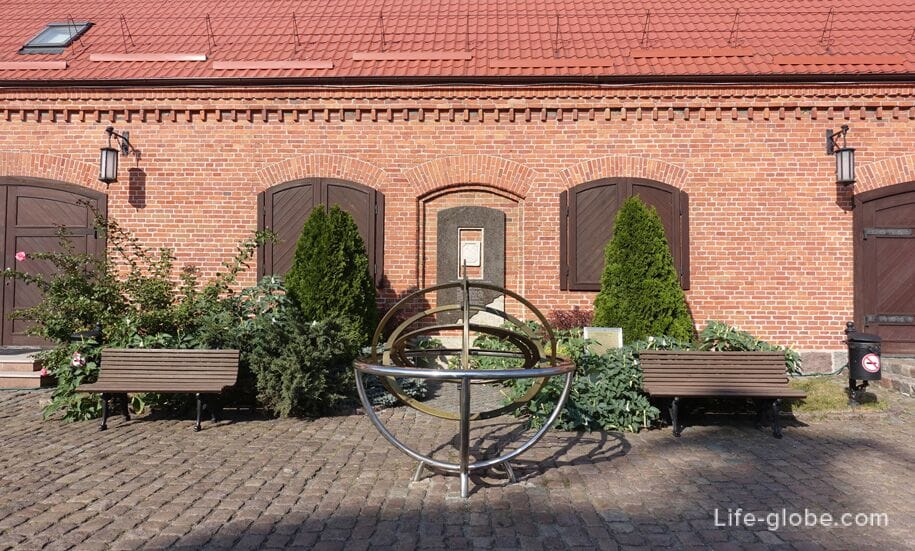
The territory of the "old port", where there are: a children's corner and a sports ground, as well as other exhibits of the museum.
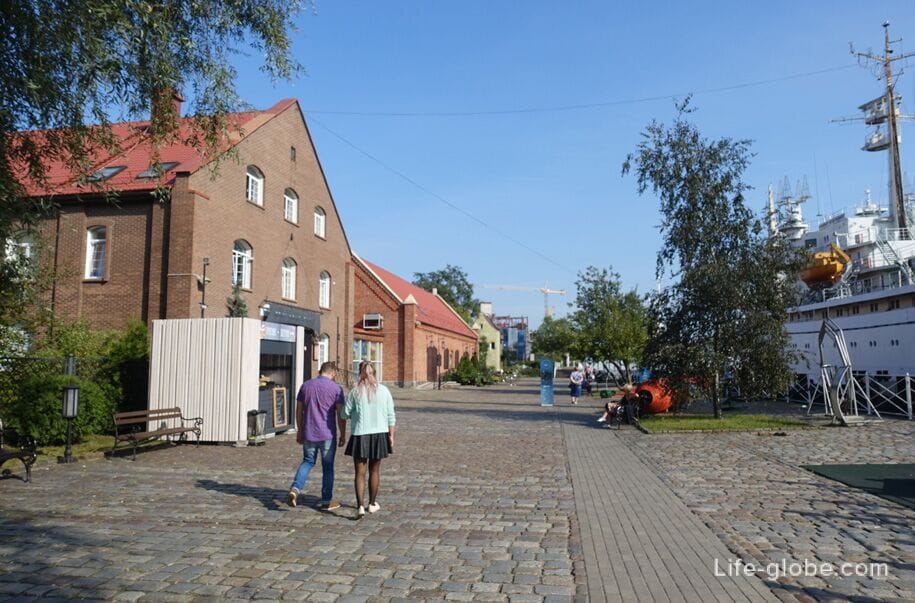
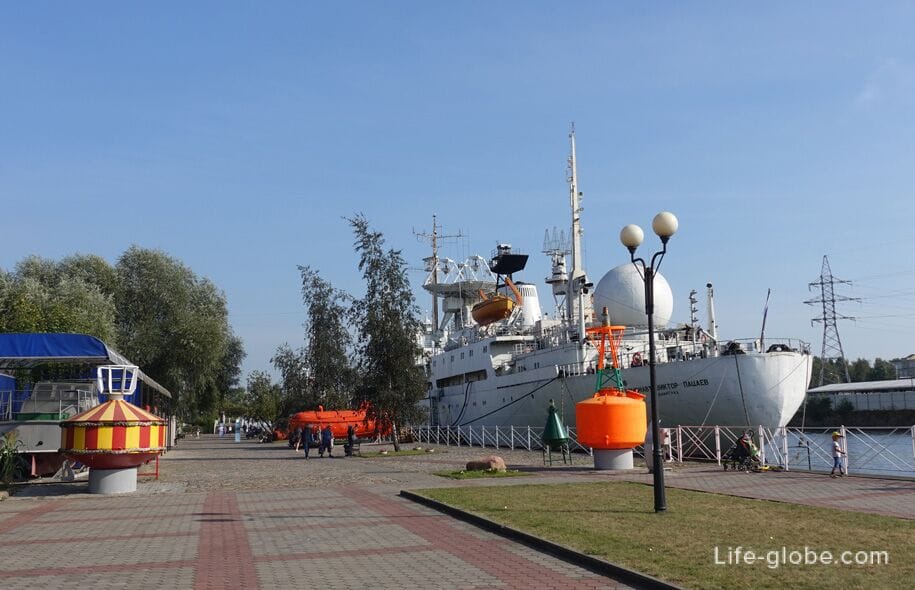
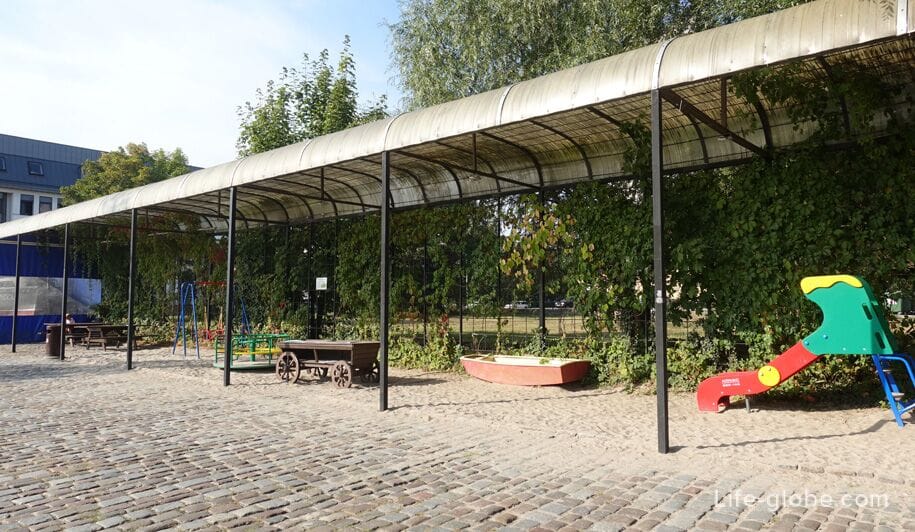
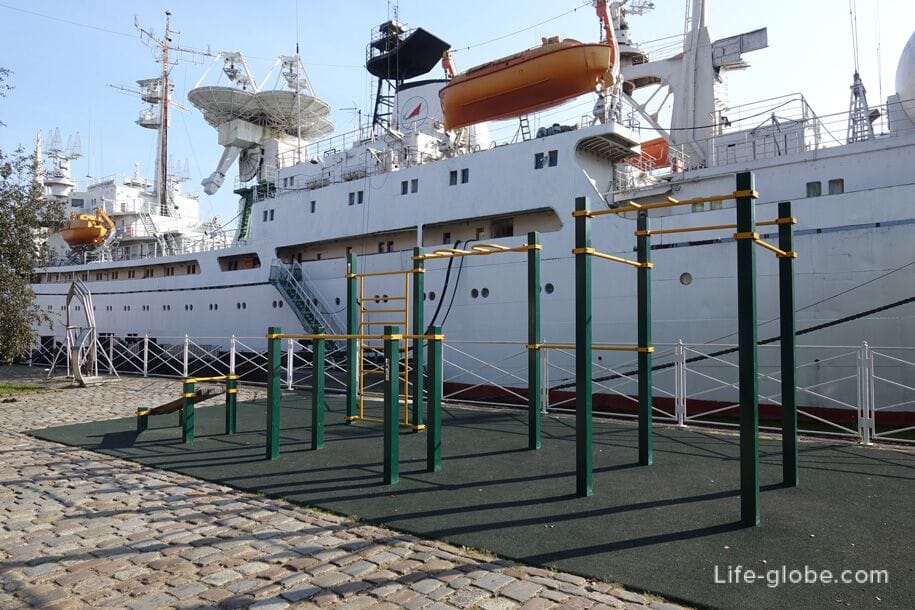

Ship navigation searchlight MSPR-L45 and Morse code

Buoy and small hydrographic boat MGK-522
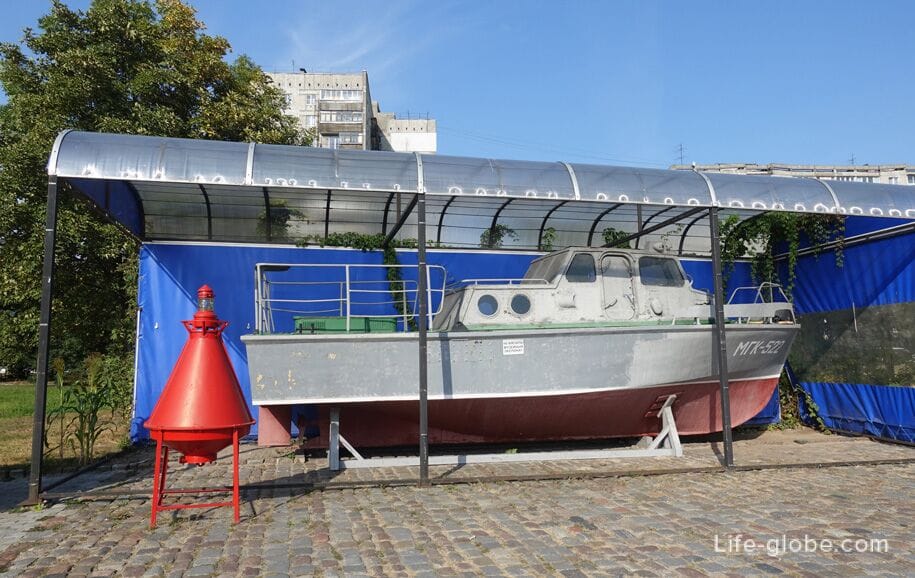
Loping is a rotating swing, a projectile for training flight personnel, astronauts and parachutists in order to increase the stability of the vestibular apparatus and the cardiovascular system to the effects of various types of accelerations.
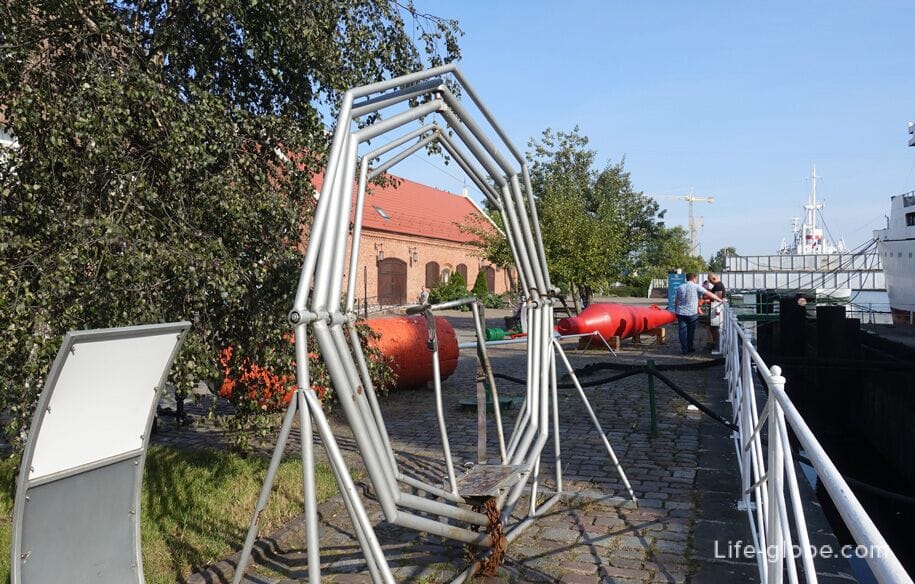
The luminous navigation sign (Koenigsberg, Germany, 1920-30s) is a means of navigation equipment of the water area, lighthouse type. It was used for navigational fencing of the sides of channels (fairways). It was installed on the shore or water on a hydraulic basis.
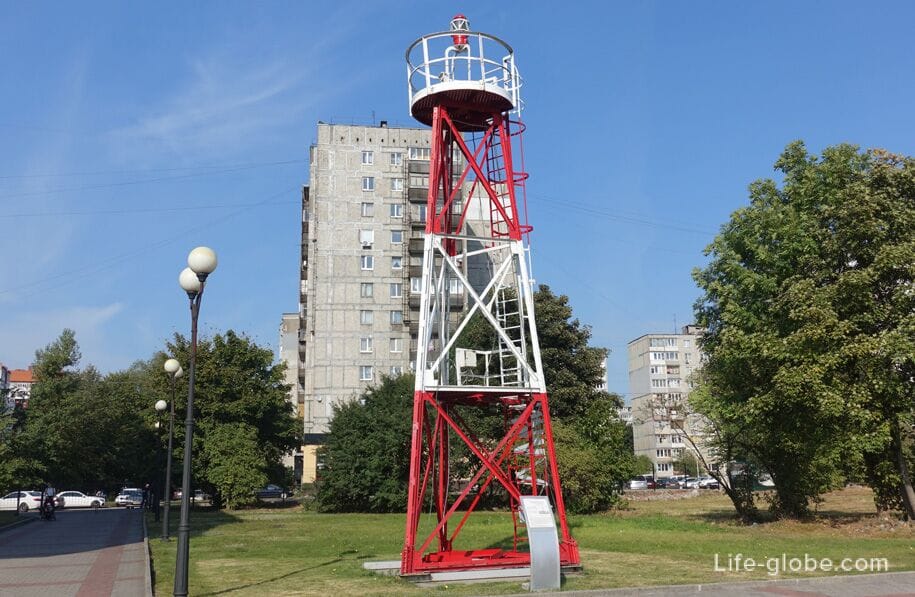
The submarine B-413 of Project 641 (Foxtrot according to the NATO classification) is the only one in the country and one of the few submarines in the world belonging to the pre-atomic period of the submarine fleet. The uniqueness of the boat also lies in the fact that it is preserved in its original form.
The submarine "B-413" was launched and became part of the USSR Navy in 1968. Until 1990, the boat was part of the Northern Fleet, later as part of the Baltic Fleet. In 2000 it was transferred to the Museum of the World Ocean. More about the submarine museum B-413...
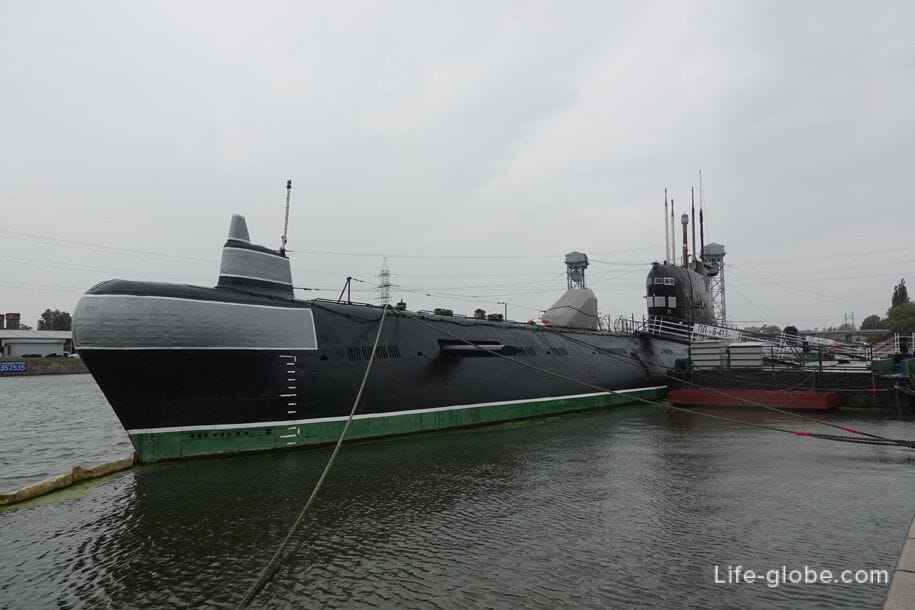
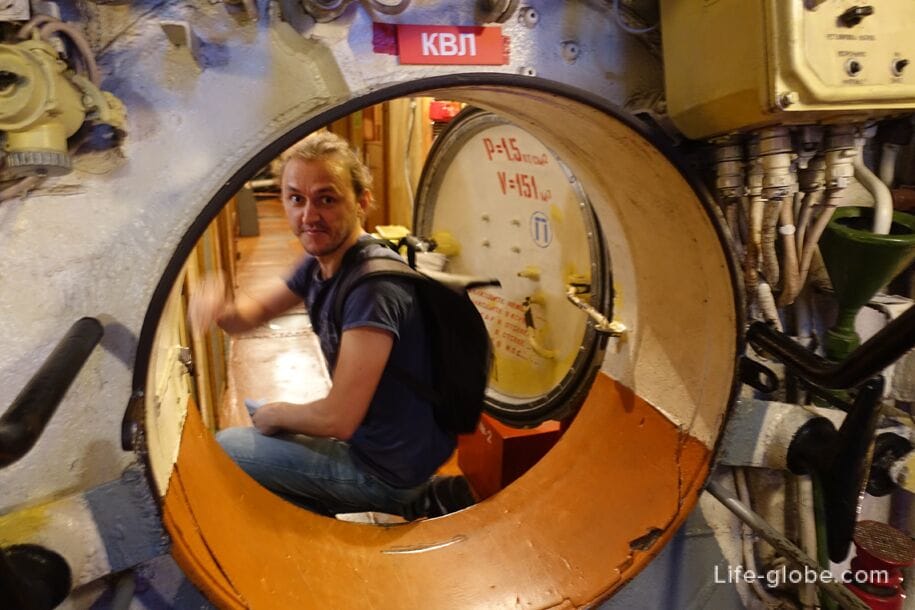
The exhibition pavilion of the naval center "Cube of Water", inside which there are: exhibition hall, cafe, watch service rooms and auxiliary rooms.
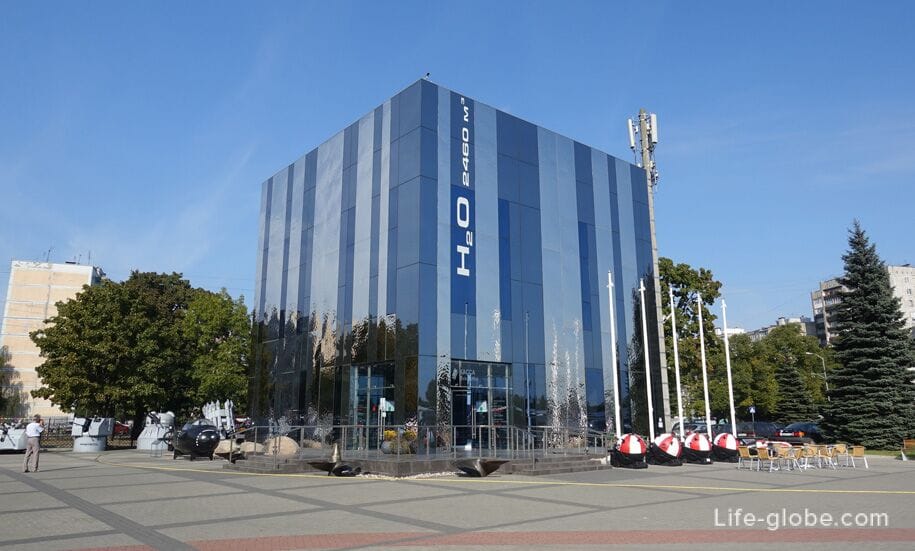
The theme of military affairs is not finished at the pavilion "Cube of Water". Near the pavilion, in an open area, there are:
- anti-submarine seaplane (amphibious aircraft) BE-12. Such aircraft were built at the Dmitrov Taganrog Aviation Plant from 1959 to 1973. A total of 143 cars were built. They were in service with anti-submarine regiments and squadrons in the Northern, Pacific, Baltic and Black Sea fleets. 42 world records were set on these planes.
Tactics of actions of these aircraft: the aircraft receives preliminary information from intelligence about the presence of a submarine in a certain area. Arriving in the area, performs an independent, or together with surface ships, search for a submarine using radar, magnetometer, AOTS. To get more accurate data about the submarine (course, speed, depth of immersion) resets the RGB series. After receiving the data, he uses a weapon. As a rule, planes operate in pairs.
The presented aircraft was released on October 27, 1970 - the last aircraft of the 49th separate anti-submarine squadron of the Baltic Fleet, based at the Kosa airfield (Baltic Spit). It was in operation for 33 years and 8 months;
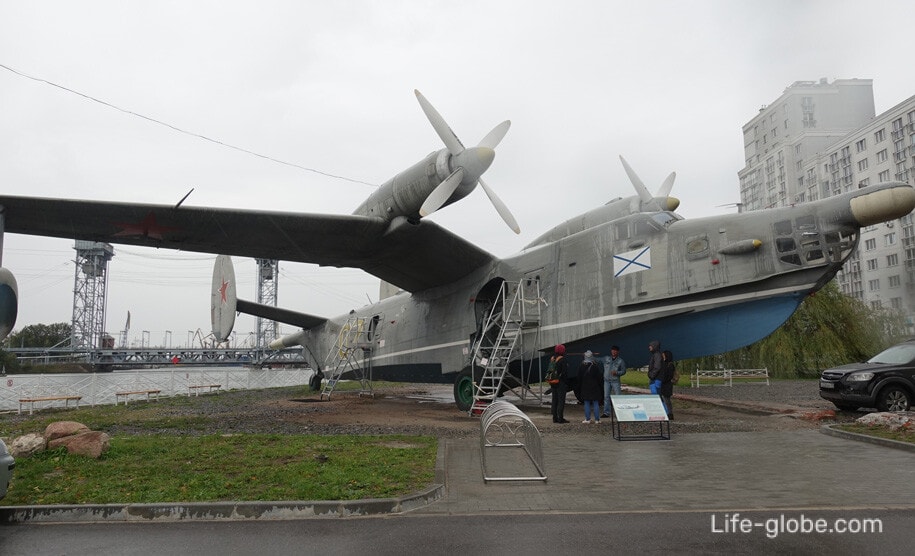
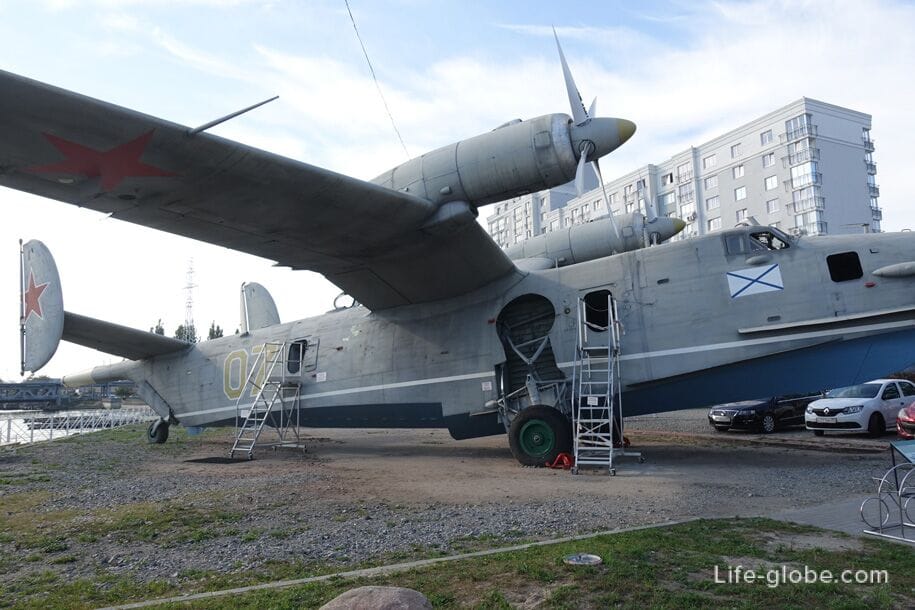
- ultra-small submarine "Triton-1M" project 907, designed to deliver combat swimmers and underwater weapons to the area of special operations of the IMF, research, rescue operations, inspection and repair of underwater structures, inspection of the seabed;
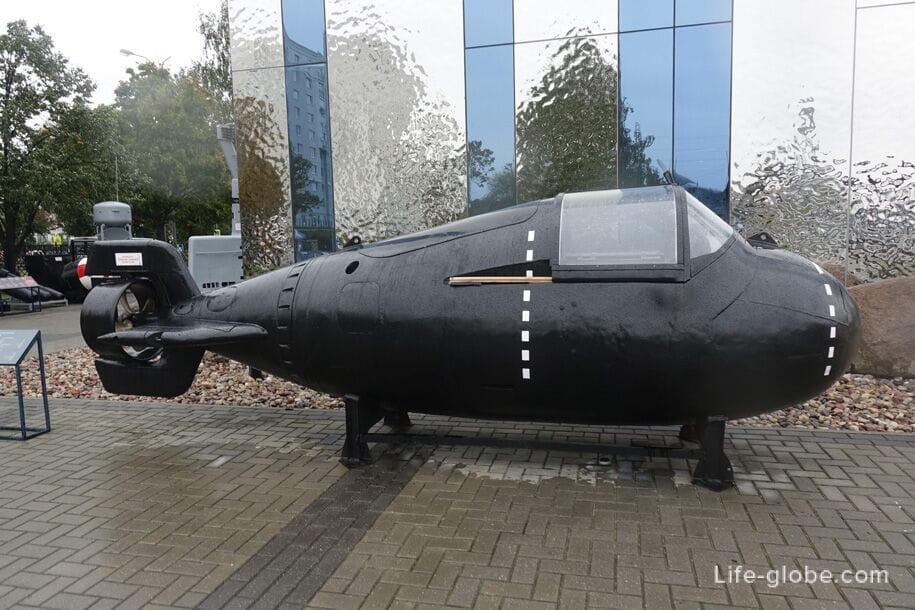
- exhibition of naval equipment: propellers of the B-413 submarine; anchor and aviation mines; jet depth charges; anti-submarine homing torpedoes; RBU-6000 rocket launcher; 70-K automatic anti-aircraft gun; paired automatic artillery installations; MGS-407 hydroacoustic station; towed acoustic trawl; DTA-53 twin-tube torpedo tube, etc.


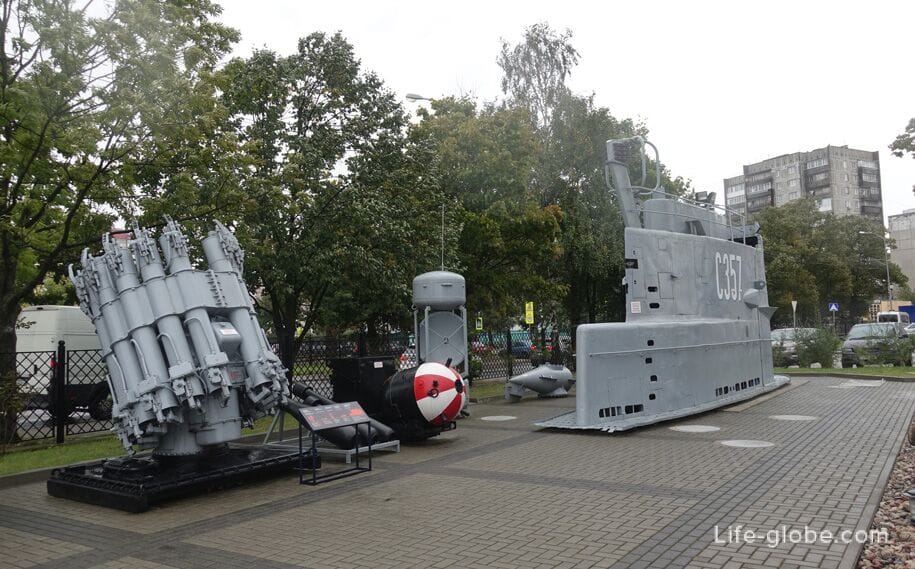
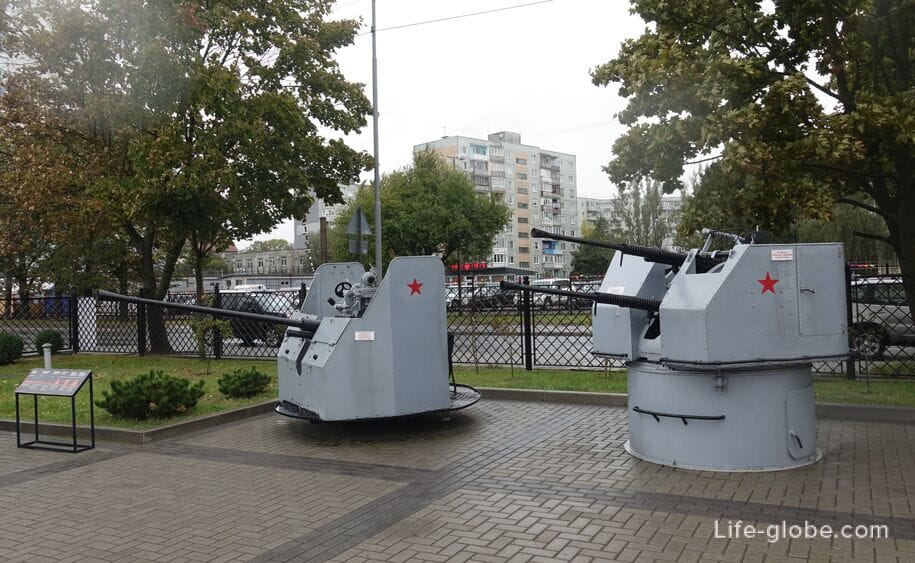

The exhibits displayed on the embankment of the Historical Fleet may change from time to time.
Opening hours of the Historic Fleet embankment: spring - summer from 09:00 to 21:00, autumn - winter from 09:00 to 19:00.
Continuation of the Peter the Great Embankment
Part of the Peter the Great Embankment, which runs east of the embankment of the Museum of the World Ocean, towards the Fishing Village, and smoothly flows into the embankment on Victor Hugo Streets, is not so in demand, but no less attractive and accessible to visitors around the clock.
Here are:
- a memorial sign to fishermen - pioneers of oceanic fishing, next to which in the warm summer months, on the Pregolya River, there are boats on which you can take a river walk;
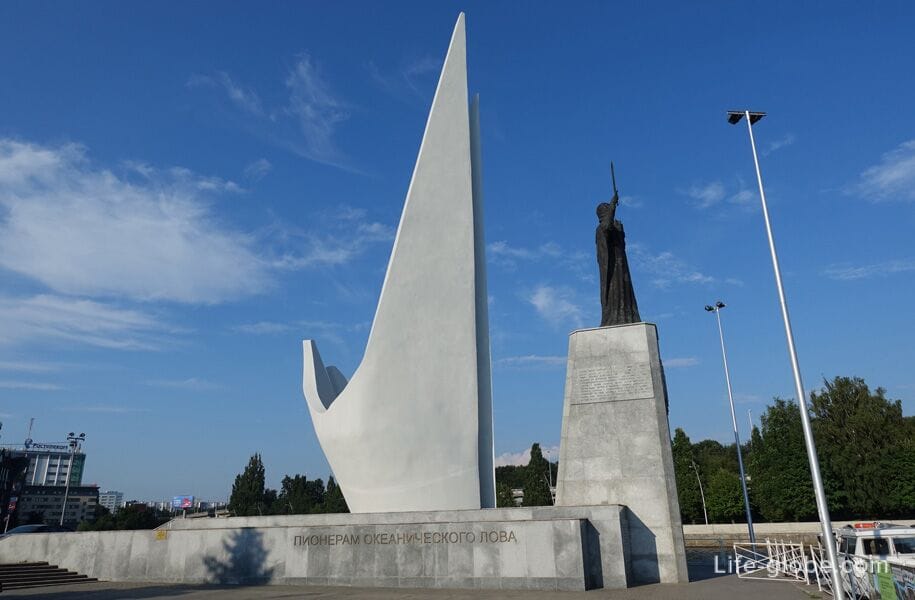
- Yunost Sports Palace;
- 4-star Holiday Inn - Kaliningrad hotel with a fitness center, a shared lounge and a bar, as well as shops and cafes on the ground floor. The rooms are equipped with a desk and a kettle. A buffet breakfast is included in the price of some rooms;
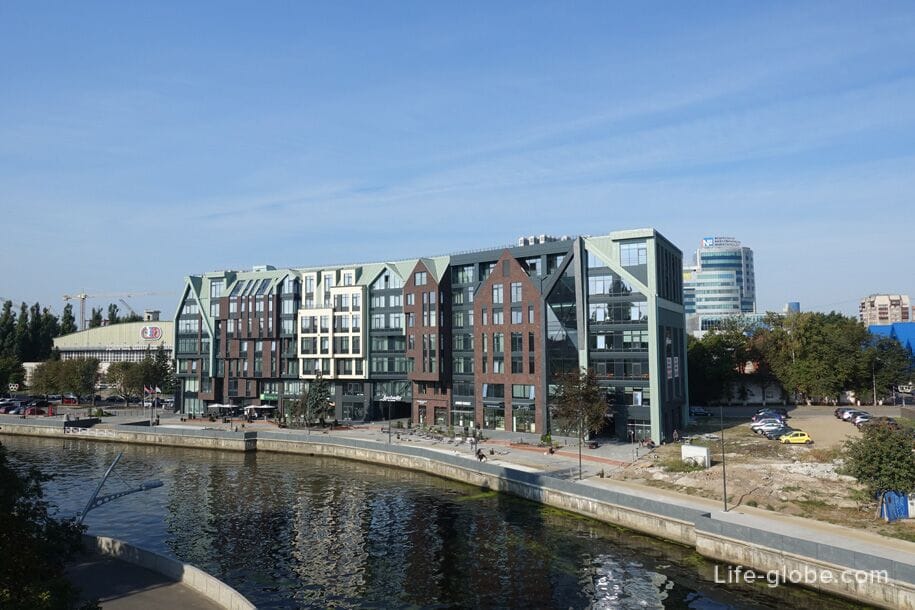
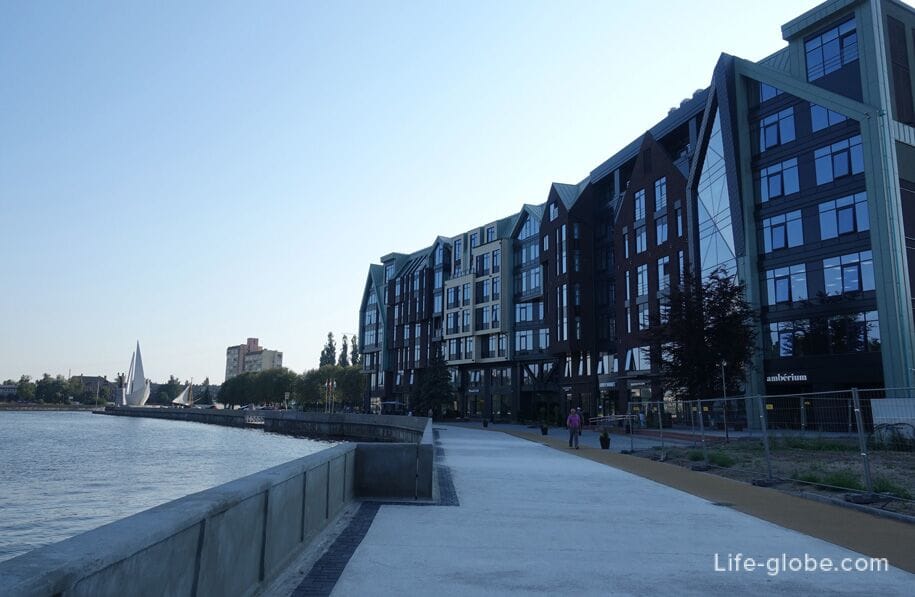
- 3-star hotel "Ibis Kaliningrad Center" with a bar, restaurant and free Wi-Fi. Breakfast is included in the price of some rooms.
